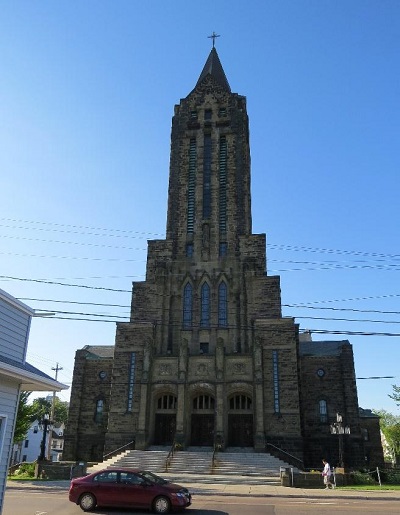Our Lady of the Assumption Cathedral National Historic Site of Canada
Moncton, New Brunswick

Façade, St. George Street
© Parks Canada | Parcs Canada
Address :
226 St. George Street, Moncton, Moncton, New Brunswick
Recognition Statute:
Historic Sites and Monuments Act (R.S.C., 1985, c. H-4)
Designation Date:
2017-07-20
Dates:
-
1914 to 1939
(Construction)
-
1940 to 1940
(Significant)
Other Name(s):
-
Our Lady of the Assumption Cathedral
(Designation Name)
-
Monument de la Reconnaissance
(Other Name)
Research Report Number:
2015-20
Plaque(s)
Existing plaque: 226 St. George Street, Moncton, New Brunswick
Built in 1939 and 1940, as the Monument of Remembrance, this cathedral is a symbol of the achievements and resilience of Acadians. It recounts their history in decorative elements, such as the tower sculpture of the Assumption of the Virgin Mary, patron saint of Acadie, capitals sculpted by Acadians, and stained glass windows depicting both secular and religious events in the history of Acadie. The exterior combines elements of Art Deco and Gothic Revival styles, while the interior is Romanesque. An affirmation of Acadian identity, the construction of this cathedral followed the creation of the Archdiocese of Moncton in 1936.
Description of Historic Place
Our Lady of the Assumption Cathedral National Historic Site of Canada is located in downtown Moncton, surrounded by private homes and small-scale commercial buildings. The building has many decorative elements that refer to the Acadian people and their history. Official recognition refers to the footprint of the building at the time of designation.
Heritage Value
Our Lady of the Assumption Cathedral was designated a National Historic Site of Canada in 2017. It is recognized for the following reasons:
• its exterior architecture is an accomplished and eclectic blend of Gothic Revival and Art Deco styles, while the interior draws from the Romanesque style. Designed and constructed in 1939-1940, it speaks to the history of the Acadian people in decorative elements found throughout the cathedral, including in the exterior sculpture of the Virgin Mary, patron saint of the Acadians, and stained glass windows depicting significant events in the religious and secular history of the Acadian people;
• built to affirm the Acadian identity and pay tribute to their resilience, its construction mobilized the Acadian community and diaspora behind a project to erect the first large-scale building commemorating them as a distinct people;
• associated with the Archdiocese of Moncton, and built shortly after its creation in 1937, the cathedral embodies the final phase of the Acadian renaissance. This place of worship continues to be a tangible symbol of the achievements of Acadians throughout their history.
Built primarily in 1939–1940, this sandstone cathedral is the mother church of the Archdiocese of Moncton. It is considered the great achievement of its first archbishop, Mgr. Louis-Joseph-Arthur Melanson (1879–1941). It stands on the former site of the crypt and unfinished chapel of Notre-Dame de l’Assomption that was used as a place of worship in the first French-speaking parish in Moncton, itself born out of the dismemberment of St. Bernard’s Parish in 1914.
Our Lady of the Assumption Cathedral, Episcopal and parish church, continues to serve as a place of religious worship (Roman Catholic) to this day. The integrity of its design, materials and execution has been maintained, despite some renovations in recent decades. The church has retained its original form and almost all of its original materials (olive sandstone from Shediac, tiles from Belgium, marble from Italy and onyx from Brazil) and the main decorative elements of the interior (sculptures, stained glass windows, murals, etc.).
The symbolic value of the cathedral stems from the fact that it is a tangible symbol of the achievements of the Acadians throughout their history and it was built to affirm the Acadian identity and embodies the Acadian Renaissance that began in the previous century.
Source: Historic Sites and Monuments Board of Canada, Minutes, December 2015.
Character-Defining Elements
The key elements that contribute to the heritage character of this site include: its location in downtown Moncton; its location on the crypt of Our Lady of the Assumption Parish, built in 1914; its monumental symmetrical façade of grey sandstone in the late Gothic Revival style with a touch of Art Deco influence, and its square central tower; its triple segmented arch arcade façade with iron gates, with sculptures crowning the spaces above the three portals; the stepped buttresses; the moulded copper cornices; lancet, oculus, and gothic arch windows, and coffered doors; its monumental exterior sculptures of the Virgin of the Assumption and the four Evangelists, carved into the stone of the pilasters, as well as its commemorative plaques and stones; its symmetrical massing and interior space, the high vaulted ceiling supported by a colonnade of arches with sculpted capitals; the interior decorative elements that embody the Acadian Renaissance, particularly the decorated capitals (crowns) on the columns facing the main altar, its two large stained glass windows depicting the religious, secular, and civic history of the Acadian people, its marble statues and its two mosaic murals; the interior woodwork, the pews and confessionals, the choir and altar details in wood, marble, and copper, the stations of the cross, the floors covered with tiles from Belgium and Italy, the chapel in honour of Monseigneur Louis-Joseph Melanson, the commemorative alcoves and the Casavant Brothers pipe organ.